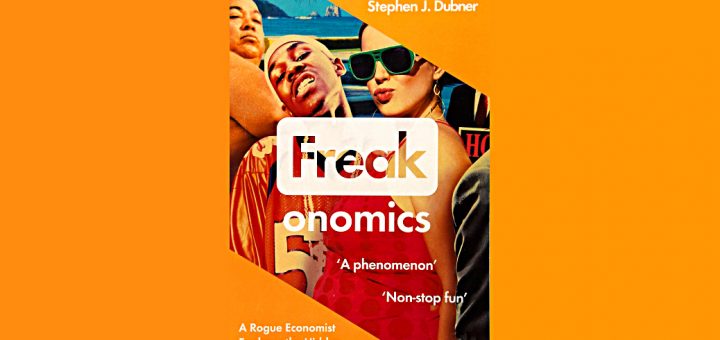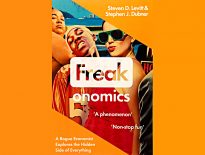Freakonomics 1 – Incentives and Cheating

Today’s post is our first visit to a classic book – Freakonomics by Steven D. Levitt and Stephen J. Dubner.
Contents
Freakonomics
The book originated way back in 2003 when journalist Dubner was sent to interview economist Levitt for a newspaper profile.
The profile was popular and publishers asked for a book.
- Levitt didn’t want to write a book (no time, not a writer) and so they agreed to do it together.
Levitt is an Economics Professor at the University of Chicago and won the John Bates Clark Medal for the most influential American economist under the age of forty.
Dubner has worked for the New York Times and written three other books.
The idea behind the book is Levitt’s:
Economics is a science with excellent tools for gaining answers but a serious shortage of interesting questions.
So this is an economics book that tries to ask more interesting questions.
- In general, Levitt tries to explain how people get what they want.
The key theme of the book is a concern with cheating, corruption, and crime.
- A secondary point is that “common sense” is often wrong.
“Experts” – from criminologists to real-estate agents – use their informational advantage to serve their own agenda.
And a third theme – the one close to my heart – is that incentives are everything:
Incentives are the cornerstone of modern life. And understanding them is the key to solving just about any riddle, from violent crime to sports cheating to online dating.
Crime
The book begins with the 1990s crime wave in the US.
- It was expected to get worse, as more city teenagers with guns arrived on the scene.
But in fact, the crime rate then went down.
The teenage murder rate fell more than 50 per cent within five years. By 2000 the overall murder rate in the United States had dropped to its lowest level in thirty-five years.
“Experts” offered a number of explanations:
- the roaring economy
- gun controls
- innovative policing strategies
But in fact, it was all down to Roe Vs Wade, and the introduction of legal abortion some twenty years earlier.
A child born into an adverse family environment is far more likely than other children to become a criminal.
And the millions of women most likely to have an abortion – poor, unmarried, and teenage mothers for whom illegal abortions had been too expensive or too hard to get – were often models of adversity.
They were the very women whose children, if born, would have been much more likely than average to become criminals.
Because these children weren’t born, fewer crimes were committed.
Real estate
The theory goes that real estate agents, though expensive, get you the best price (“top dollar”).
- Unfortunately, the incentives don’t work that way.
On the sale of a $300,000 house, a typical 6 per cent agent fee yields $18,000.
It’s true that the real-estate agent has an informational advantage:
She is better informed about the house’s value, the state of the housing market, even the buyer’s frame of mind.
But estate agents act in their own interest.
- So do doctors and car mechanics, but that’s more difficult to prove because they don’t provide the same services to themselves as a matter of public record.
But estate agents often sell their own houses, and when they do, they behave differently.
A recent set of data covering the sale of nearly 100,000 houses in suburban Chicago shows that more than 3,000 of those houses were owned by the agents themselves.
A 6 percent real-estate commission is typically split between the seller’s agent and the buyer’s. Each agent then kicks back roughly half of her take to the agency. Which means that only 1.5 percent of the purchase price goes directly into your agent’s pocket.
So when she sells your $300K house, she only gets $4.5K of the $18K commission.
- If the house sells for $310K instead, she makes an extra $150 (compared to your extra $9.4K).
Of course, when selling her own house, she keeps all of the extra $10K.
It turns out that a real-estate agent keeps her own home on the market an average of ten days longer and sells it for an extra 3-plus percent, or $10,000 on a $300,000 house.
When she sells her own house, an agent holds out for the best offer; when she sells yours, she encourages you to take the first decent offer that comes along.
Like a stockbroker churning commissions, she wants to make deals and make them fast.
Campaign spending
People believe that money buys elections, and indeed, US election data show hat the candidate who spends more money usually wins.
But we need to avoid confusing correlation with causation.
- For example, cities with a lot of murders also tend to have a lot of police officers, but the police are not responsible for the murders.
There are two reasons for making campaign donations:
- a close race, where the money might make a difference
- a sure winner, who you would like to be on the right side of
Incumbents and front-runners obviously have more cash, but they only spend a lot of it when they stand a legitimate chance of losing.
So in a race where one candidate is more immediately appealing:
The appealing candidate raises much more money and wins easily. But was it the money that won him the votes, or was it his appeal that won the votes and the money?
The test is when the same candidates run against each other in successive elections, spending different amounts of money.
As it turns out, the same two candidates run against each other in consecutive elections all the time–indeed, in nearly a thousand U.S. congressional races since 1972.
And the amount of money spent makes almost no difference.
A winning candidate can cut his spending in half and lose only 1 percent of the vote. Meanwhile, a losing candidate who doubles his spending can expect to shift the vote in his favor by only that same 1 percent.
Bloomberg’s expensive run at the 2020 Presidency tallies with this conclusion (though you might say that he won by shifting the Democratic candidacy from Sanders to Biden).
Daycare
After this introduction, Chapter One begins with parents who are late collecting their children from daycare.
- When a daily $3 fine was introduced, more parents turned up late.
Since the monthly fee for the nursery was $380, it could be argued that the fine was too small – it clearly didn’t provide enough of an incentive.
An incentive is simply a means of urging people to do more of a good thing and less of a bad thing.
Sin taxes on beer and fags are good examples, as are (or should be) prison sentences and fines.
- In the opposite direction, as investors, we get tax breaks for saving for our retirement, and for investing in startups that would otherwise find it difficult to raise funds.
A carbon tax would be a good incentive that doesn’t currently exist.
There are three basic flavors of incentive: economic, social, and moral. Very often a single incentive scheme will include all three varieties.
Smoking has the economic tax, the social pressure of not lighting up in public and the (dubious) moral incentive that terrorists raise cash by selling black-market cigarettes.
- The declining rate of murder through history suggests that society is doing a surprisingly good job with these incentives.
The other problem with the daycare fine was:
It substituted an economic incentive (the $3 penalty) for a moral incentive (the guilt that parents were supposed to feel when they came late).
And the small size of the fine signalled that late pickups weren’t such a big problem for the day-care centre.
Blood donations
A similar example comes from blood donations.
- You don’t get paid for donating blood in the UK, but sometimes you do in the US.
But when there is a small payment, people donate less blood.
- Once again the moral incentive (performing a noble act of charity) is replaced by an economic one (a boring, time-consuming and possibly painful way to make a few dollars).
When there’s no moral incentive to begin with (eg. when taking part in a market research focus group), money can help a lot.
What about offering more money for blood?
- This creates its own problems – for $5K, people would steal blood and try to pass off animal blood as human.
The old stories about natives breeding rats and cobras when colonial rules introduced bounties for dead bodies support this.
- Which brings us to cheating.
Cheating
As W. C. Fields once said: a thing worth having is a thing worth cheating for.
Everyone cheats if the incentives are right (and you have a reasonable expectation that you won’t be caught).
One example from the book concerned social security in the US.
- In 1987, the Internal Revenue Service introduced a requirement to provide a Social Security number for each dependent child (which allowed filers to access tax breaks).
Overnight, seven million children vanished from the forms.
The second example is 3rd-grade teachers in Chicago.
- Schools are incentivised to get good grades from their pupils, and sanctioned when they fail.
Schoolchildren, of course, have had incentive to cheat for as long as there have been tests. But high-stakes testing has so radically changed the incentives for teachers that they too now have added reason to cheat.
If her students do well enough, she might find herself praised, promoted, and even richer: the state of California at one point introduced bonuses of $25,000 for teachers who produced big test-score gains.
One option for soft cheating is teaching to the test, rather than the entire syllabus.
- Or more directly, you can allow extra time to complete the test.
Worst of all, you could fill in the blank answers on their (multiple-choice) answer papers.
If you were willing to erase your students’ wrong answers and fill in correct ones, you probably wouldn’t want to change too many wrong answers or even change answers on every student’s test – another tip-off. Nor would you have enough time.
So what you might do is select a string of eight or ten consecutive questions and fill in the correct answers for, say, one-half or two-thirds of your students. You might focus your activity toward the end of the test, where the questions tend to be harder. In that way, you’d be most likely to substitute correct answers for wrong ones.
So researchers analysed the data – the Chicago test answers for every student from third grade through seventh grade from 1993 to 2000.
- That was 30K students per grade per year, 700K sets of test answers, and 100M individual answers.
The first thing to search for would be unusual answer patterns in a given classroom: blocks of identical answers, for instance, especially among the harder questions. If ten poor students [based on past performance] gave correct answers to the last five questions on the exam (the hardest ones), that’s worth looking into.
Another red flag would be a strange pattern within any one student’s exam–such as getting the hard questions right while missing the easy ones. A dramatic one-year spike in test scores might initially be attributed to a good teacher; but with a dramatic fall to follow, there’s a strong likelihood that the spike was brought about by artificial means.
Around 5% of teachers were found to be cheating.
- A study of North Carolina schoolteachers found that 35% had seen their colleagues cheating in some fashion.
A cheating teacher tends to be younger and less qualified than average. She is also more likely to cheat after her incentives change [following the introduction of high-stakes testing].
Sumo
In Japan, sumo is not only the national sport but also a repository of the country’s religious, military, and historical emotion.
So it might seem surprising that the sport (like so many others) is somewhat corrupt.
An athlete who gets caught cheating is generally condemned, but most fans at least appreciate his motive: he wanted so badly to win that he bent the rules. An athlete who cheats to lose, meanwhile, is consigned to a deep circle of sporting hell.
The 1919 Chicago White Sox, and Marlon Brando’s boxer in On the Waterfront are provided as examples.
All his troubles stemmed from the one fight in which he took a dive. Otherwise, he could have had class; he could have been a contender.
So cheating to lose in Sumo?
- The data from 32K bouts between 281 wrestlers from January 1989 to January 2000 would suggest so.
The incentives here are that the top 66 wrestlers have a great life; the lower-ranked ones, not so much.
A wrestler’s ranking is based on his performance in the elite tournaments that are held six times a year. Each wrestler has fifteen bouts per tournament, one per day over fifteen consecutive days.
You need an 8-7 or better record to improve your ranking – the 8th victory is crucial.
- So the cheating is in the final bout, with 8-6 wrestlers agreeing to lose to 7-7 wrestlers who need the win much more.
- 9-5 wrestlers might also throw bouts, but those with better records will be aiming for prizes.
The 7-7 wrestler, based on past outcomes, was expected to win just less than half the time. But in actuality, the wrestler on the bubble won almost eight out of ten matches against his 8-6 opponent.
7-7 wrestlers also outperformed against 9-5 opponents.
Of course, since so much depends on the eighth win, a 7-7 wrestler would be expected to fight harder in the crucial bout.
- The clinching proof comes from the return bouts.
Let’s look at the win-loss percentage between the 7-7 wrestlers and the 8-6 wrestlers the next time they meet, when neither one is on the bubble.
With no pressure on the bout, you would expect win rates similar to their previous matches rather than the last one.
- So 50% wins rather than 80%.
But instead, you get 40% wins in the next match.
The most logical explanation is that the wrestlers made a quid pro quo agreement: you let me win today when I really need the victory, and I’ll let you win the next time. By the two wrestlers’ second subsequent meeting, the win percentages revert to the expected level of about 50 percent.
The collective records of the various sumo stables are similarly aberrational. When one stable’s wrestlers fare well on the bubble against wrestlers from a second stable, they tend to do especially poorly when the second stable’s wrestlers are on the bubble.
Additionally, when match-rigging is mentioned in the media, it disappears in the next tournament.
Bagels
In 1984, a guy called Paul Feldman switched from being an under-appreciated Washington analyst to selling bagels in offices.
Early in the morning, he would deliver some bagels and a cash basket to a company’s snack room; he would return before lunch to pick up the money and the leftovers. It was an honour-system.
Within a few years, Feldman was delivering 8,400 bagels a week to 140 companies and earning as much as he had ever made as a research analyst.
But since he kept good data on his sales and receipts, he was also conducting an experiment.
- How honest were his customers?
- Who stole from him, and how much?
He came to consider a company “honest” if its payment rate was above 90 percent. He considered a rate between 80 and 90 percent “annoying but tolerable.” If a company habitually paid below 80 percent, Feldman might post a hectoring note.
In the beginning, Feldman left behind an open basket for the cash, but too often the money vanished. In the end, he resorted to making small plywood boxes with a slot cut into the top.
On average, just one of his 7,000 deliveries per year resulted in a stolen cash box.
Some observations from Feldman’s data:
- from 1992 to 2001 the payment rate slowly slipped to 87%
- after 9/11 it increased to 89% (ie. 15% less theft)
- smaller offices outpay by 3% to 5%
- good weather leads to higher payments
- major holidays (Xmas, Valentines’) are bad – people are preoccupied and stressed
- long weekend weeks (bank holidays) are good – people are happy with the extra day off work
- good office morale leads to higher payments
- senior employees cheat more
Conclusions
It’s been many years since I first read this book, and I’m pleasantly surprised how well it has stood the test of time.
- We’ve covered around a fifth of the book so far, so there should be another four articles to come (plus a summary).
I look forward to the next instalment.
- Until next time.
















